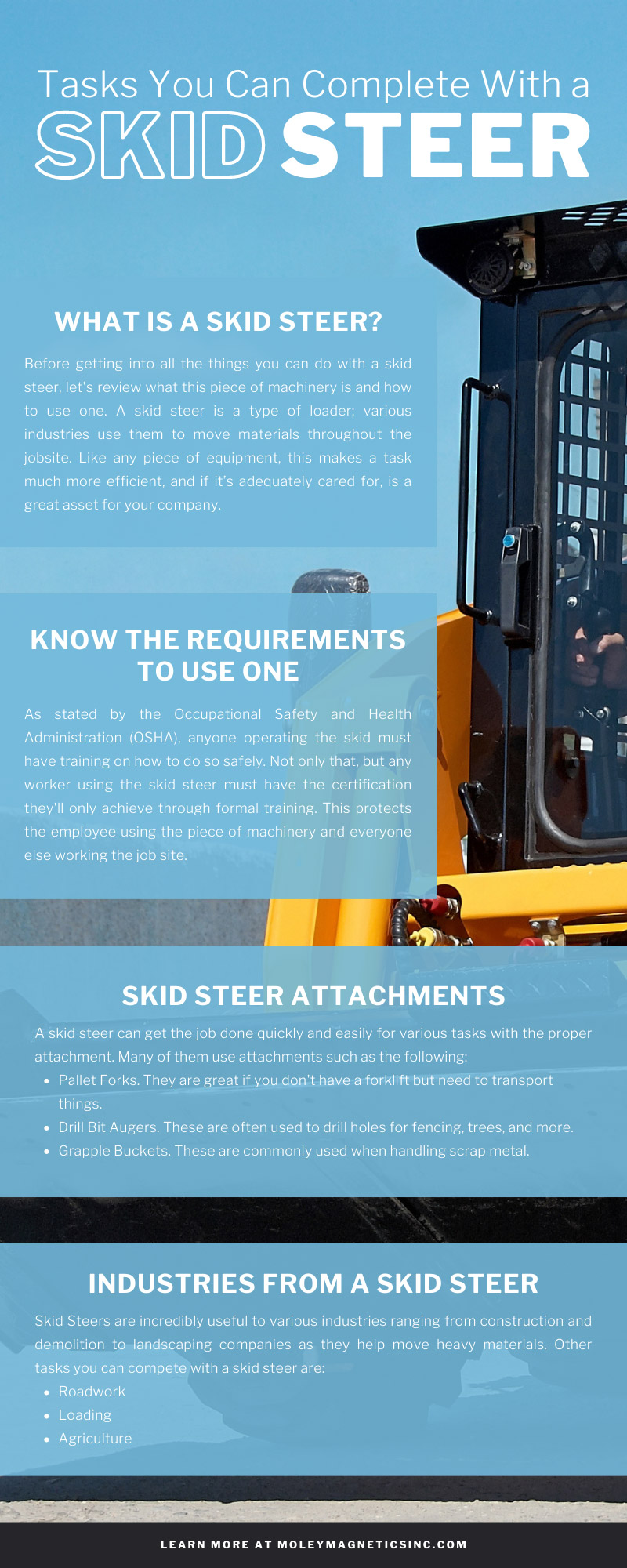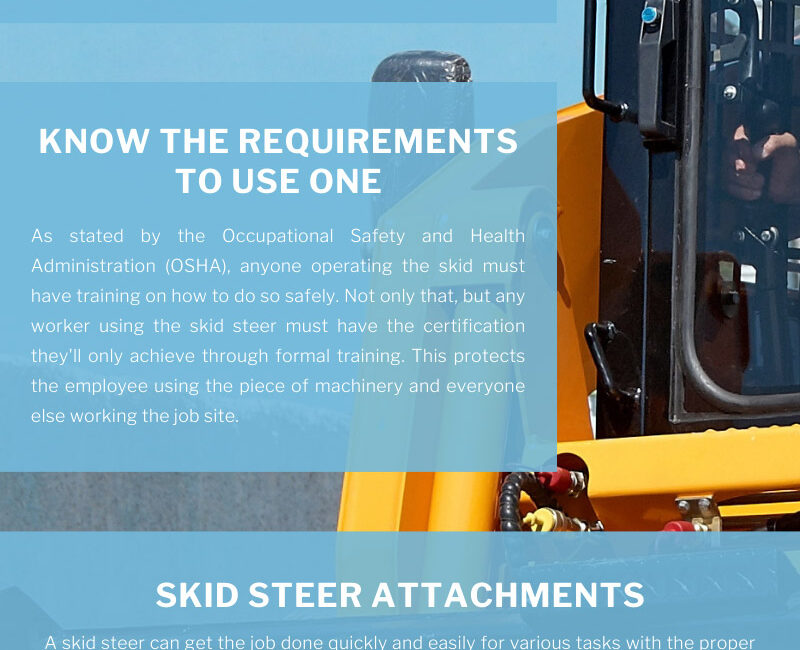Hey there! Have you ever wondered if skid steers can be used for material handling? Well, you’ve come to the right place to find out! Skid steers are versatile machines commonly used in construction, landscaping, and agriculture. But can they handle the task of material handling? Let’s dive in and explore this topic together.
When it comes to material handling, skid steers can be an excellent choice. These compact machines are designed to maneuver in tight spaces, making them perfect for moving materials in crowded job sites. With their small size and powerful engines, skid steers can easily lift and transport various types of material, such as pallets, rocks, and even logs.
One of the key advantages of using skid steers for material handling is their versatility. With different attachments, like forks, buckets, or grapples, skid steers can adapt to different types of material, allowing for efficient and effective handling. Whether you need to load, unload, stack, or carry materials, skid steers can get the job done!
So, if you’re looking for a machine that can handle material with ease and flexibility, skid steers are a fantastic choice. With their maneuverability, power, and versatility, these compact machines offer a reliable solution for all your material handling needs. Stay tuned as we dive deeper into the world of skid steers and explore their capabilities in material handling.

Can Skid Steers Be Used for Material Handling?
Skid steers are versatile and powerful machines that are commonly used in construction, landscaping, and various other industries. Their compact size and maneuverability make them ideal for navigating tight spaces and working in challenging terrains. While most people associate skid steers with tasks such as digging and grading, they can also be used for material handling. In this article, we will explore the capabilities of skid steers when it comes to material handling and discuss their benefits, limitations, and tips for efficient use.
The Versatility of Skid Steers
Skid steers are widely recognized for their versatility, as they can be equipped with a wide range of attachments to perform various tasks. When it comes to material handling, skid steers can be fitted with buckets, pallet forks, or even specialized attachments like grapple buckets or bale spears. These attachments allow skid steers to efficiently move and transport materials such as gravel, soil, sand, rocks, pallets, and even logs.
With their powerful hydraulic systems and agile maneuverability, skid steers can easily scoop, lift, and transport materials across job sites. Whether you need to load or unload materials onto trucks, move materials from one location to another, or organize and stack materials on pallets, skid steers can handle the task with precision and efficiency. Their compact size enables them to access tight spaces or navigate through narrow pathways, making them highly effective for material handling in confined areas.
Benefits of Using Skid Steers for Material Handling
There are several benefits to using skid steers for material handling:
- Efficiency: Skid steers are designed for productivity, and their ability to quickly scoop, lift, and transport materials saves time and labor compared to manual handling methods.
- Maneuverability: Skid steers can easily navigate around obstacles, tight corners, and uneven terrain, enabling efficient material handling even in challenging job site conditions.
- Compact Size: The compact size of skid steers allows them to work in confined spaces, such as construction sites, warehouses, or residential yards, where larger machines would struggle to maneuver.
- Versatility: Skid steers can be equipped with a wide array of attachments, making them adaptable for various material handling tasks. From buckets for bulk materials to forks for palletized goods, skid steers can tackle a range of materials and applications.
- Cost-Effective: Utilizing a skid steer for material handling can increase overall efficiency and reduce the need for manual labor, which can result in cost savings for businesses.
While skid steers offer numerous benefits for material handling, it’s important to consider their limitations and implement certain tips for optimal use.
Limitations and Tips for Using Skid Steers for Material Handling
Despite their versatility, skid steers do have some limitations when it comes to material handling:
- Load Capacity: Skid steers come in different sizes and have varying load capacities. It is crucial to ensure that the skid steer you’re using has the appropriate load capacity for the materials you are handling to avoid overloading or compromising safety.
- Stability: Skid steers have a narrow wheelbase, which can impact stability, especially when lifting heavy loads. It’s essential to operate within the manufacturer’s specified load and height limits to maintain stability and prevent accidents.
- Traction: Due to their compact size and weight distribution, skid steers may experience reduced traction when fully loaded. It is crucial to assess the terrain and make necessary adjustments to minimize the risk of slippage or loss of control.
To ensure efficient and safe material handling with skid steers, consider the following tips:
- Understand the load capacity of your skid steer and never exceed it to avoid accidents or damage to the machine.
- Regularly inspect and maintain your skid steer, paying close attention to hydraulic systems, tires, and control mechanisms, to ensure optimal performance and safety.
- Train operators on proper material handling techniques and safety precautions, including load positioning, weight distribution, and safe maneuvering.
- Utilize attachments that are specifically designed for material handling tasks to improve efficiency and reduce the risk of damage to the machine or the materials being handled.
- Be mindful of the terrain and adjust your approach as needed to ensure stability and prevent accidents.
Conclusion
Skid steers are indeed capable of material handling tasks. With their versatility, agility, and wide range of attachments, they can efficiently move, transport, and organize various materials on job sites. By understanding their benefits, limitations, and implementing proper techniques and safety precautions, skid steers can be valuable assets for material handling operations, improving productivity and reducing labor costs. So, the next time you have material handling needs, consider harnessing the power and versatility of skid steers.
Key Takeaways: Can Skid Steers Be Used for Material Handling?
– Skid steers can be used for material handling, making them versatile machines on construction sites.
– These compact machines are equipped with a bucket attachment, which allows them to move and transport various materials.
– Skid steers are ideal for tasks like loading and unloading construction materials, moving debris, and even landscaping.
– With their maneuverability and small size, skid steers can access tight spaces, making them efficient for material handling in confined areas.
– However, it’s important to note that the weight capacity of skid steers may vary, so it’s essential to choose the right model for the specific material handling needs.
Frequently Asked Questions
Welcome to our FAQ section, where we provide answers to common questions about using skid steers for material handling. Whether you’re a construction professional or someone interested in understanding skid steers better, we’ve got you covered. Read on to find out more!
Q: What is material handling, and can skid steers be used for it?
A: Material handling refers to the movement, storage, control, and protection of materials within a facility or construction site. Skid steers are incredibly versatile machines that can perform various tasks, including material handling. With their compact size, maneuverability, and attachment options, skid steers are ideal for lifting, carrying, and placing materials in different locations. Whether it’s moving pallets, loading/unloading trucks, or transporting construction materials, skid steers excel at material handling tasks.
Skid steers equipped with specific attachments like forks, buckets, or pallet forks can handle different types of materials, including pallets, lumber, gravel, soil, and even large debris. They provide efficient and precise material handling solutions, making them a popular choice in industries like construction, landscaping, agriculture, and warehousing.
Q: Are there any limitations to using skid steers for material handling?
A: While skid steers are versatile machines, they do have some limitations for material handling. One factor to consider is their load capacity. Depending on the model and size, skid steers typically have a maximum load capacity ranging from 1,000 pounds to over 4,000 pounds. If you need to handle particularly heavy materials, you may need a larger machine with higher lifting capacity.
Additionally, the stability of skid steers can be a concern when working with heavy loads or on uneven terrain. It’s crucial to operate the machine within its stability parameters and ensure that the load is properly secured. If you’re working on rough or unstable surfaces, a compact track loader might be a better option, as it offers superior stability and traction in such conditions.
Q: What are the benefits of using skid steers for material handling?
A: Skid steers offer several benefits for material handling tasks. Firstly, their compact size allows them to maneuver in tight spaces, making them ideal for working in crowded construction sites or warehouses where space is limited. They can easily navigate through narrow aisles or doorways to transport materials where larger machines might not fit.
Secondly, skid steers have excellent visibility from the operator’s seat, providing better control and safety during material handling operations. The operator can easily see the attachment, load, and surrounding environment, reducing the risk of accidents. Additionally, skid steers with advanced features like joystick controls and telescopic booms further enhance the operator’s efficiency and productivity.
Q: Can skid steers be equipped with different attachments for material handling?
A: Yes, skid steers can be equipped with a wide range of attachments that are specifically designed for material handling tasks. Some popular attachments include pallet forks, buckets, grapples, augers, and bale spears. Each attachment serves a specific purpose, allowing the skid steer to handle different materials with ease and precision.
For example, pallet forks are commonly used to lift and transport palletized goods, while buckets are suitable for moving loose materials like soil, gravel, or debris. Grapples are ideal for handling bulky items such as brush or logs, and augers are useful for drilling holes in the ground for fence posts or tree planting. The versatility of skid steer attachments makes them incredibly adaptable for various material handling applications.
Q: What safety precautions should be taken when using skid steers for material handling?
A: When operating skid steers for material handling, it’s essential to prioritize safety. Here are some key precautions to follow: Firstly, operators should receive proper training on how to operate the machine and use attachments safely. Understanding the controls, load limits, and stability considerations is crucial to prevent accidents.
It’s important to wear appropriate personal protective equipment (PPE), including a hard hat, safety glasses, high-visibility clothing, and steel-toed boots. Before starting any material handling task, perform a thorough equipment inspection to ensure everything is in proper working condition. Finally, secure the load properly, following manufacturer guidelines, to prevent materials from falling or shifting during transport.
What Can You Do with a Bobcat Skid Steer – Tools Tools Tools
Summary
If you’re wondering whether skid steers can handle materials, the answer is yes! Skid steers are versatile machines that can be used for various tasks, including material handling. With their compact size and maneuverability, they can easily navigate tight spaces and transport heavy loads. However, it’s important to use the right attachments and follow safety guidelines to ensure efficient and safe material handling operations. By doing so, skid steers can be a valuable asset for your work needs.
In conclusion, skid steers are capable of handling materials effectively. Their versatility, compact size, and maneuverability make them ideal for material handling tasks. It’s essential to use the right attachments and prioritize safety to maximize their efficiency and avoid any accidents. So, go ahead and consider using skid steers for your material handling needs!

